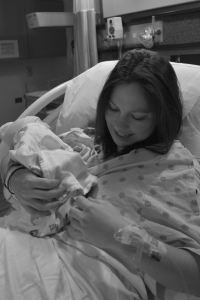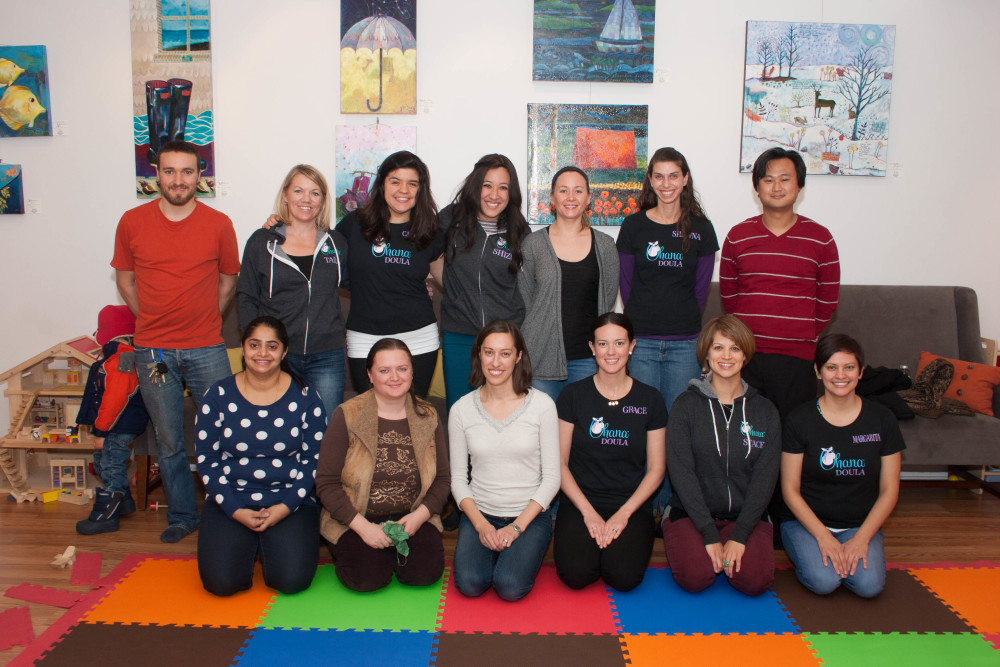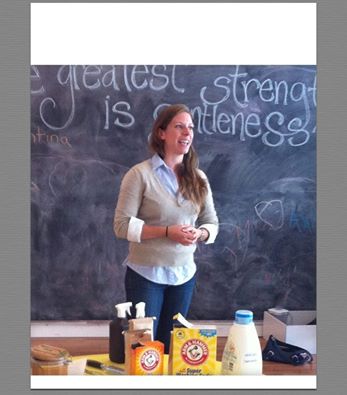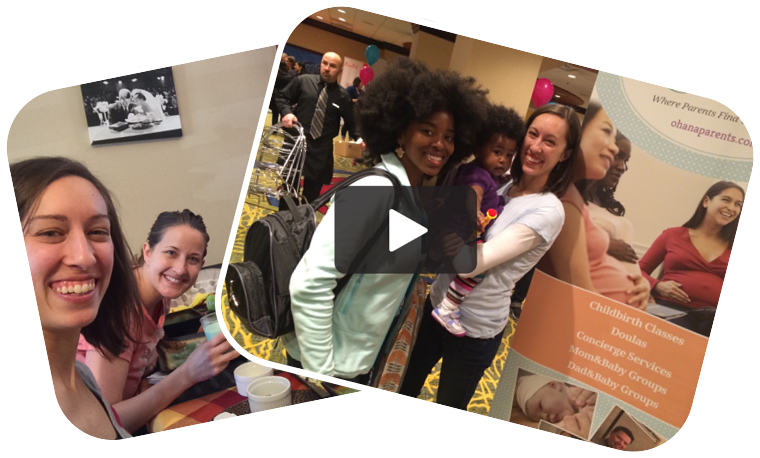
Here is a lovely birth story from one of our recent clients. Shared with permission of course.
FROM CESAREAN TO UNMEDICATED BIRTH
My second son was born October 29th. I’ve been reflecting on his birth ever since trying to sort through everything that went down, everything I felt, and everything that happened after. I wanted to write down my “birth story.” Turns out the whole story isn’t about one day, but takes place over almost 2 years involving multiple people and places. Here I attempt a 30,000 ft view of the events, and I know even that will be too long for most to read! But, I wanted to share anyway.
My first son was born via unplanned cesarean December 2012. I went into that birth pretty clueless. Sure, my husband and I took the class offered by the hospital, which was a big help, but that was it. I didn’t read any books, talk to other mothers, or do any prep on my own other than diligently seeing my OB throughout my pregnancy. I was admitted into the hospital immediately after going in for the stress test 4 days after the baby was due. Overnight I slept best as I could in the hospital bed but periodically nurses rushed in response to the fetal distress shown on the monitors. Finally around 6am the OB said it was time to just take him out. I accepted it, not moved one way or another. I sat calmly while my husband suited up, and I was even calm as the spinal was administered. (And here I skip a lot of stuff…basically cesareans aren’t as easy as one would think) I’ll never forget that alien feeling when I first heard my son cry. “That’s my son,” I thought. In an instant, I was a mom. Mom. What a weird word, especially when it suddenly applied to me.
When I became pregnant with baby #2 I assumed I’d try for a regular birth, since that is how it is “supposed” to happen. But, I was shocked when at my first OB appointment the Dr. started talking repeat Cesarean as if it was a done deal. She told me to go ahead and schedule it because the calendar books up quickly. I left the appointment a little numb. No factors such as my health, my wishes, my recovery, etc were even discussed. Of course I’d have a repeat Cesarean. This didn’t feel right. What was wrong with trying for a regular birth? Shortly after I read an article saying that the assistance of a doula can increase your chances for a successful regular birth. After getting more serious about the hope for a VBAC (vaginal birth after cesarean) and discussing the idea with my husband, we hired a doula we loved to join our team. (Check out Tara’s website here if you are considering a doula! She’s fabulous.)
Once she was on board I got really serious about this birth. I read 4 books about natural or regular birth, the best one being “Birthing from Within” recommended by our doula, Tara. I practiced relaxation techniques daily. I kept a journal to process my fears, thoughts, and emotions about the pregnancy and birth. I even connected with my inner hippie and made birth art. I was eager to hear other women’s birth stories and asked as many moms as I could to tell me theirs. I joined ICAN (International Cesarean Awareness Network) online. I studied the risks, stats, and success rates of VBACs. I spent a lot of time thinking about and drafting a birth plan. I learned more about OBs and why they do what they do and why so many are wary of VBACs. Soon I was talking exclusively in birth lingo in online forums, understanding completely when another woman posted “I had my VBA2C at 40+3 with DH and ds8 present.”
While sitting in bible study at church 4 days after my due date I finally felt them: contractions! For some reason I knew these were the real deal. I happily marked a tally in my study booklet for each contraction, blissfully unaware at the work ahead. Once home I took a shower, shaved my legs, and dyed my hair (because of pictures, duh!). The day dragged on along with the mild contractions. That night I slept on the couch and eventually woke my husband up in the middle of the night during a false alarm. He joined me on the couch where I slept fitfully until the morning. We called our doula over and sent Ashton away to our neighbors for the day. Things didn’t get really going until about 1pm. Suddenly, the contractions took a turn and were stronger and close together. I labored at home with my husband and our doula’s help. I wanted to stay home as long as possible to avoid unnecessary interventions or pressure from the staff at the hospital. But at around 5:30pm I was ready to go. After checking in and going through triage, we set up camp in the labor and delivery room.
Here is where things got interesting. I don’t even know how to adequately describe it, and it will never fully make sense to women who haven’t also been through it. It is like the difference between reading a book about how to skydive, and actually skydiving. You can’t grasp the experience without well, the experience. Active labor is a true force of nature. An amazing, crazy, powerful, unbelievable force of nature. Like a tsunami. Suddenly it just takes you on a ride, with or without you. You are present, but you aren’t part of it. Your body has 100% taken over. Yet, there is this incredible sense of freedom in active labor. You lose control, in the best possible way. You become this powerful, primal creature. There is no past, there is no future, your whole being is focused on the present which is thrown into sharp relief, second by second. Everything else in the room melts away as you shout, moan, and move in submission to labor’s force. Your body knows what to do even though you have no idea. Your body is doing something crazy and beautiful and insane. You are partnered with God bringing forth new life, united with Mother Earth in labor’s power, and brought into this sacred sorority of all other mothers. Labor is hard, then it gets harder. When you can’t take it anymore, it gets even more difficult. When it feels impossible to go on, you somehow do.
I was tired and asked for pain relief. After all, I only got a 45 min stretch then another 1.5 hour stretch of sleep the night before. I’ve been awake for essentially over 36 hours at this point other than a couple cat naps. The nurse checked my progress and cheerfully announced I was 10cm dilated, too late for drugs, it’s almost time to push!
Now that was a crazy moment. When I heard her say there would be no drugs, I was a mixed bag of conflicting emotions. First, I cursed myself for waiting too long to ask seriously for pain relief. Then I thought, wow…I’m actually going to do this. I’m going to achieve something I never thought in 100 years I could do. I was scared and empowered at the same time.
When it was time for the baby to make his debut, the room filled with staff and supplies. The big light was lowered from the ceiling. I was told that when it’s time to push, you will instinctively know what to do. I didn’t. In a panic I asked those around me, “How do I push?” My OB calmly talked me through it. After pushing through a contraction I’d look up into my husband and doula’s faces to gather strength for the next one. After a few more contractions and the appropriately named ring of fire (holy hell that hurt), baby was out. “Look at him, look at him!” the staff exclaimed. Afraid of what I’d see I squinted open just one eye as he was lifted up. And then there it was, that first baby cry as his lungs filled with air for the first time. Suddenly the baby I’ve been day dreaming about for months is real.
The main event was over, but the room still buzzed with activity. My OB stitched me up while a nurse collected linens into the biohazard bag (and it was a big bag. Birth is messy!). My husband stood near the baby, describing to me what he saw as the staff checked him over. Utterly and completely exhausted I was too nervous to hold the baby right away in fear of dropping him. My husband held the baby skin to skin himself. After gathering up what was left of my energy, I finally held my new little boy. It felt completely normal yet bizarre at the same time. Another baby boy! You could see the plates of his skull, and the ridges where they moved during birth. I loved his bumpy head. To me it looked as if he was wearing a crown. A well-deserved crown after what we both accomplished.
Thank You for sharing your story with us Jaclyn Levy. Click here to visit Jaclyn Levy’s blog .









